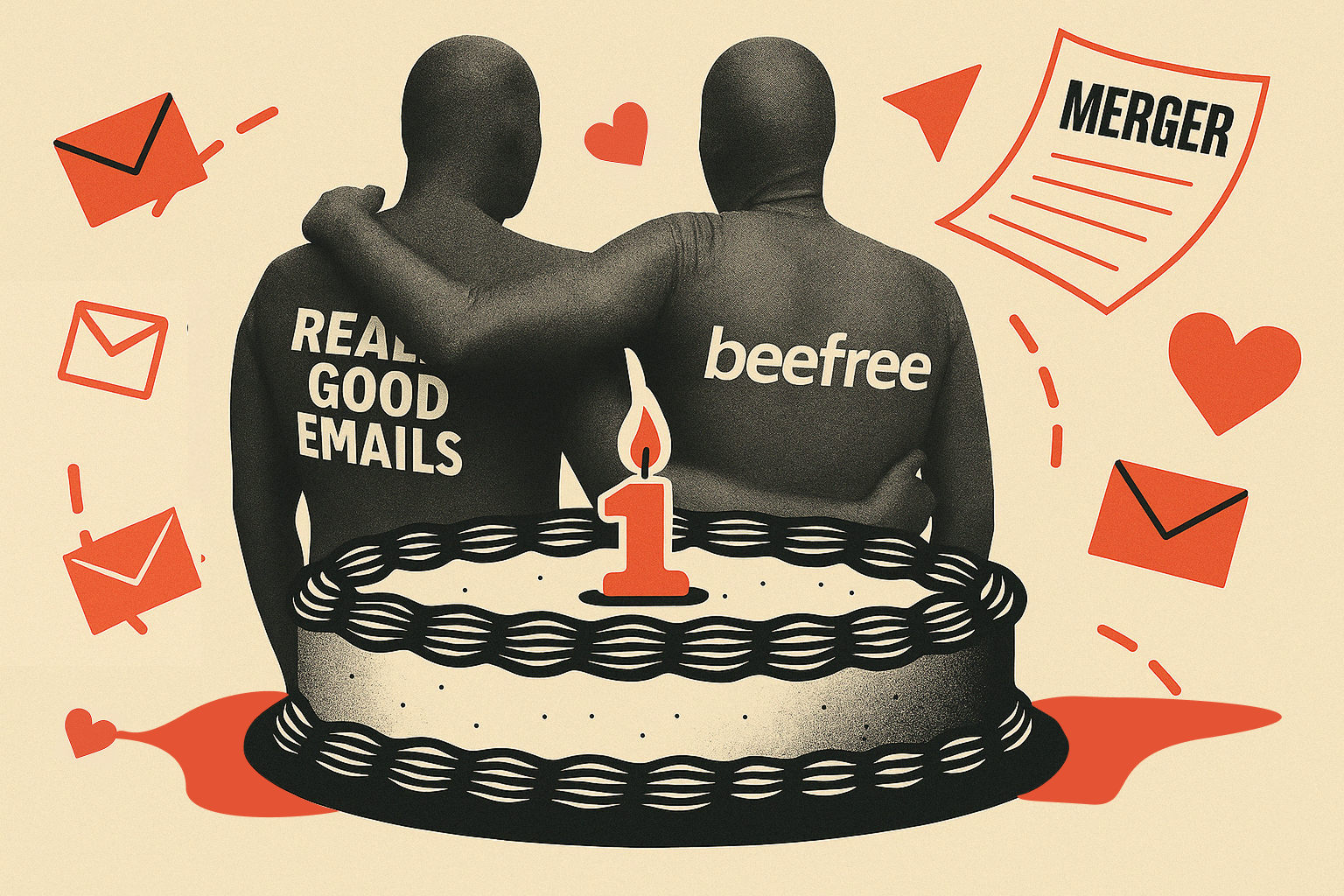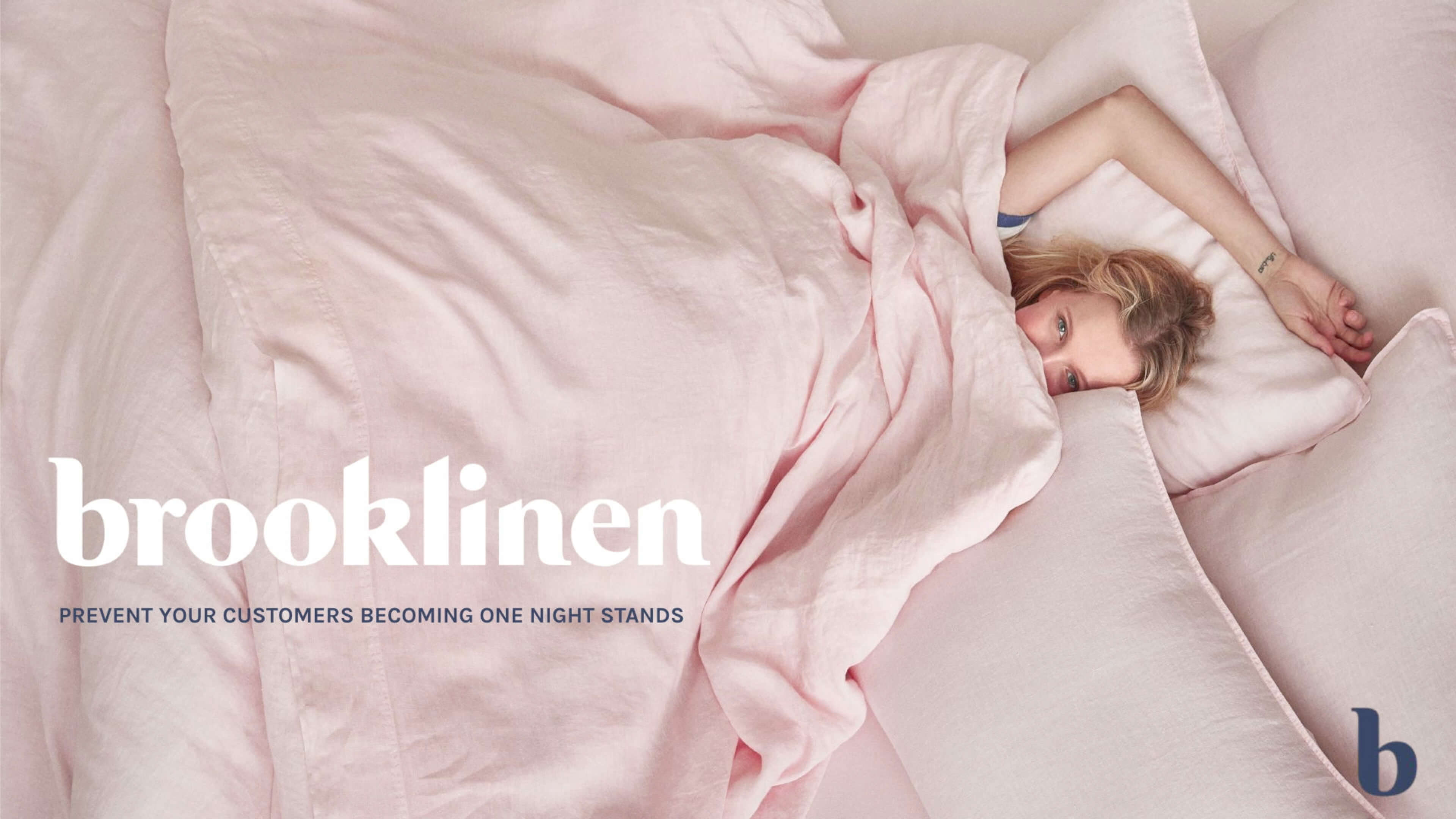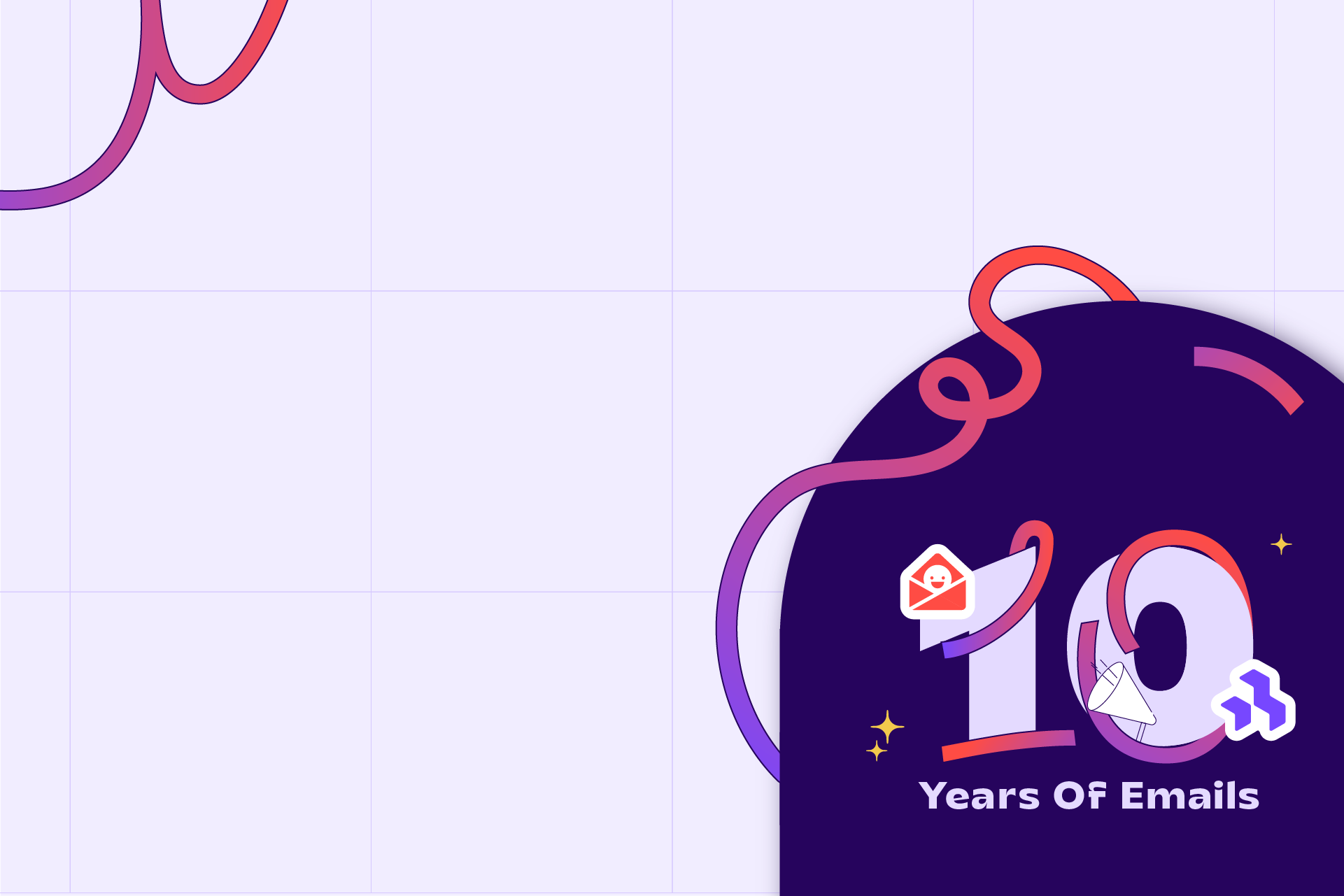Allie Donovan: You're probably wondering why I'm here to talk to you about relationships, so I thought I'd tell you a little bit about myself.

This is the love of my life, his name is Dougal, and he's a seven-year-old Beagle who enjoys long walks on the beach. I thought about putting my husband up here, but honestly, Dougal is much cuter.
So I would describe myself as a retention marketer. I've worked in retail and D2C brands for the last ten years. I'm 20. I just look a lot older. I work on a small, scrappy team, and like a lot of the email teams out there, like just yesterday, we learned that most teams are three people or less.
I'm a little bit of everything. I don't have an analyst, engineer, email developer, or therapist, so I kind of do a little bit of all of those on the team. How many of them I do well is debatable, but we give it a good go.
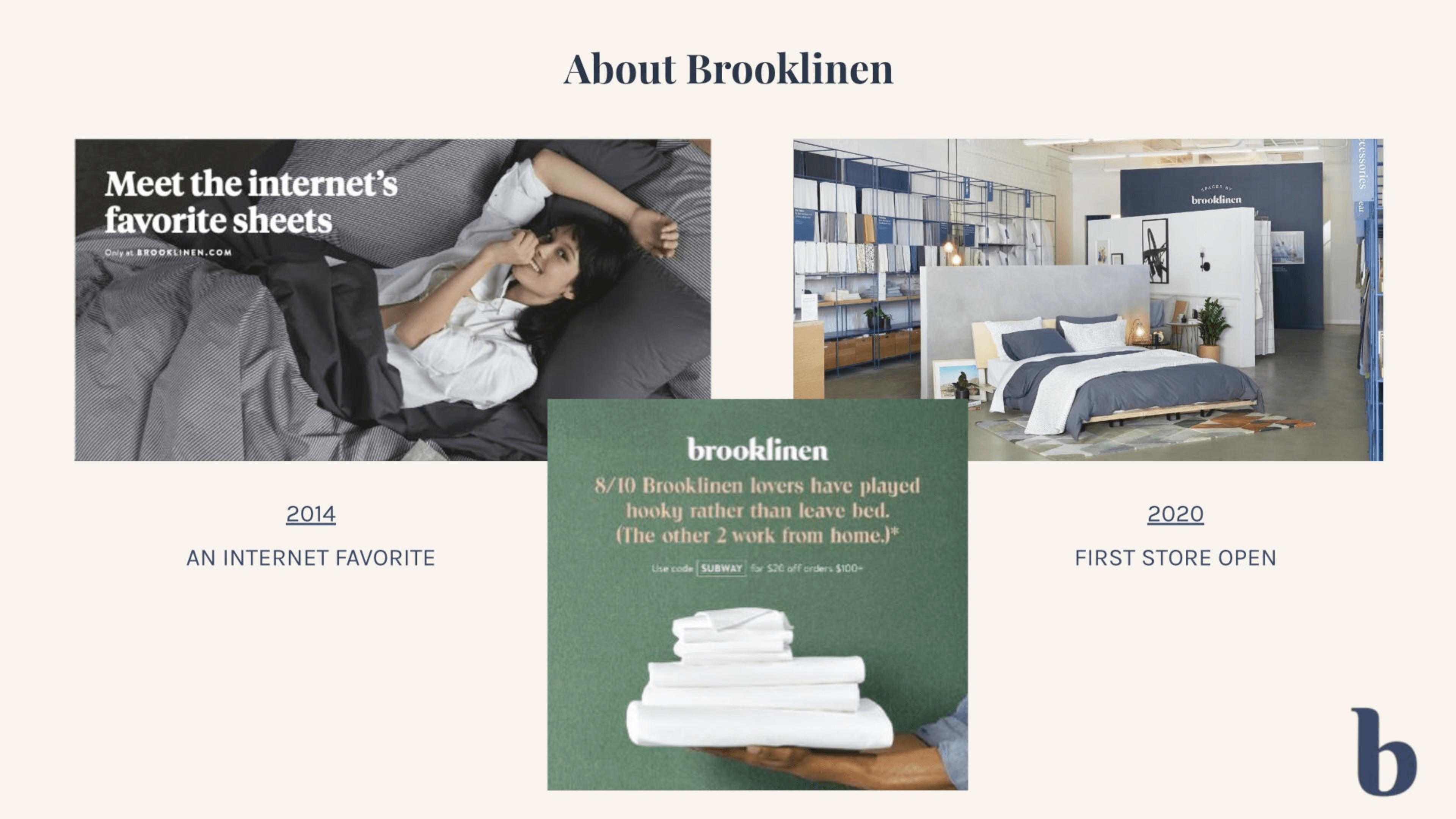
So a little bit about Brooklinen for those that don't know it (shame on you). We started in 2014 from a husband and wife team that went on vacation and had a great night's sleep, and they loved the sheets. So, they went down to the hotel reception and said, can we buy the sheets? And they said yes, of course. The reception then said the sheets would be $800, and Richard and Vicky, our co-founders, were like "ouch." They then dedicated their lives to finding out how they can make a great set of sheets that did not cost them that kind of money.
So that was in 2014, and it's six years later. We opened our first store this year in Williamsburg, New York. So we're branching into the retail world. We have discovered many things along the way - even things like the shop fittings. If you want to try your sheets and feel the sheets, most shop fittings are not made for hanging up sheets. It's been an exciting road, but here we are.
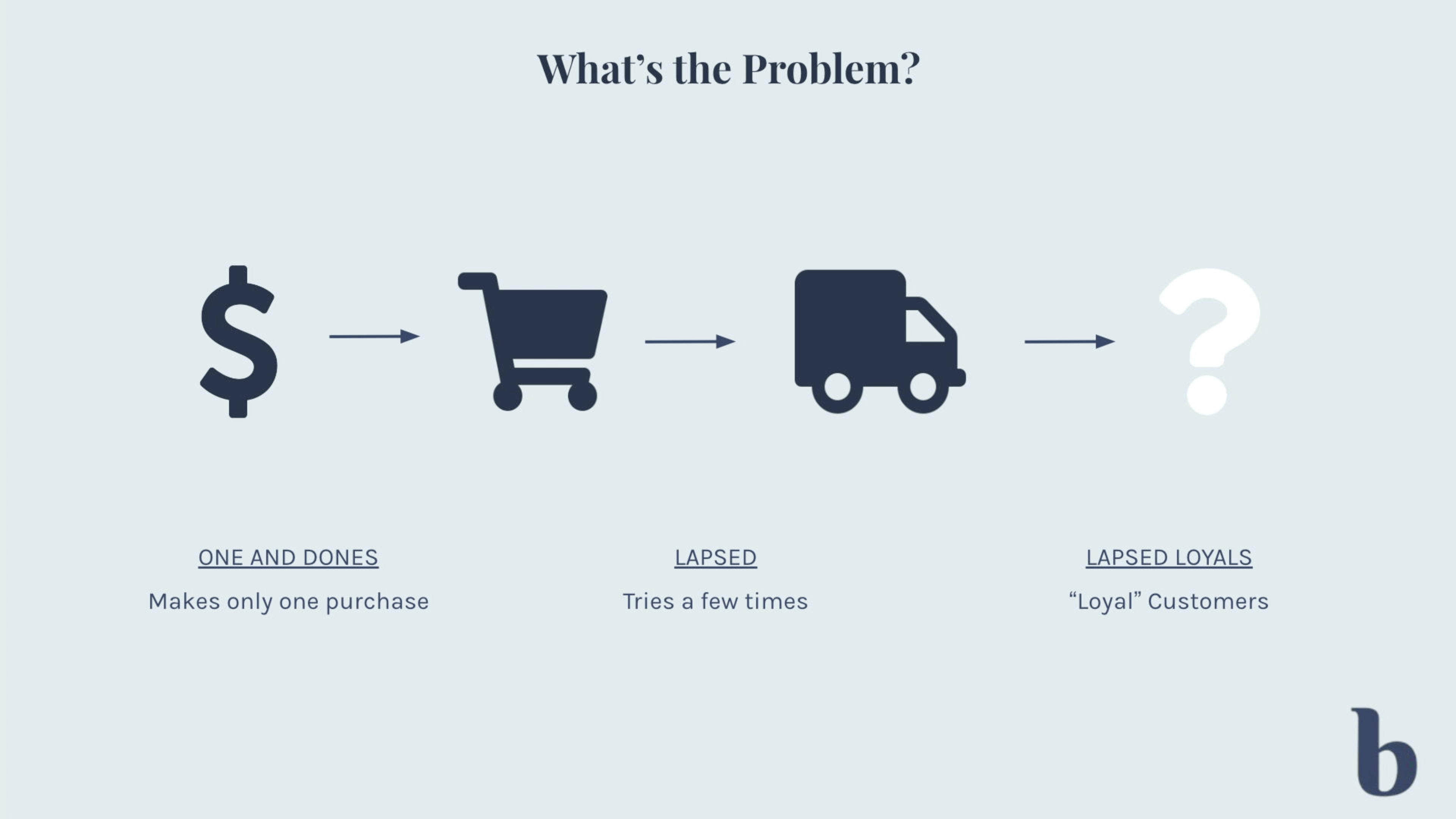
I'm going to talk to you about retention. I want to talk to you about what is the problem? Your growth team or acquisition team has probably spent a lot of money getting a customer in your door. They come, they put something in their cart. Hopefully, they purchase, and then they ghost you. If you're lucky, they might visit you a few times before they leave you, but chances are, at some point, they're going to leave you.
So the way I think about this is there are three separate groups of how much I dislike these people. There are your "one and dones" or your one night stands. They come, and sometimes they cost a fortune to come in, so you don't even make it back on your first purchase, and then poof, they're gone. They never get in touch again, and you don't know why.
Then, we have the lapsed customers, they try you a few times, and they liked you the first time, so they came back, but then they disappear. Then, my lapsed loyals. These guys drive me crazy. They told me they were loyal because they came back enough times that I thought they were faithful, and then they disappeared too.
Naturally, people will disappear, but what we want to do is figure out how to get as many of those back in the door so that I can keep my job.
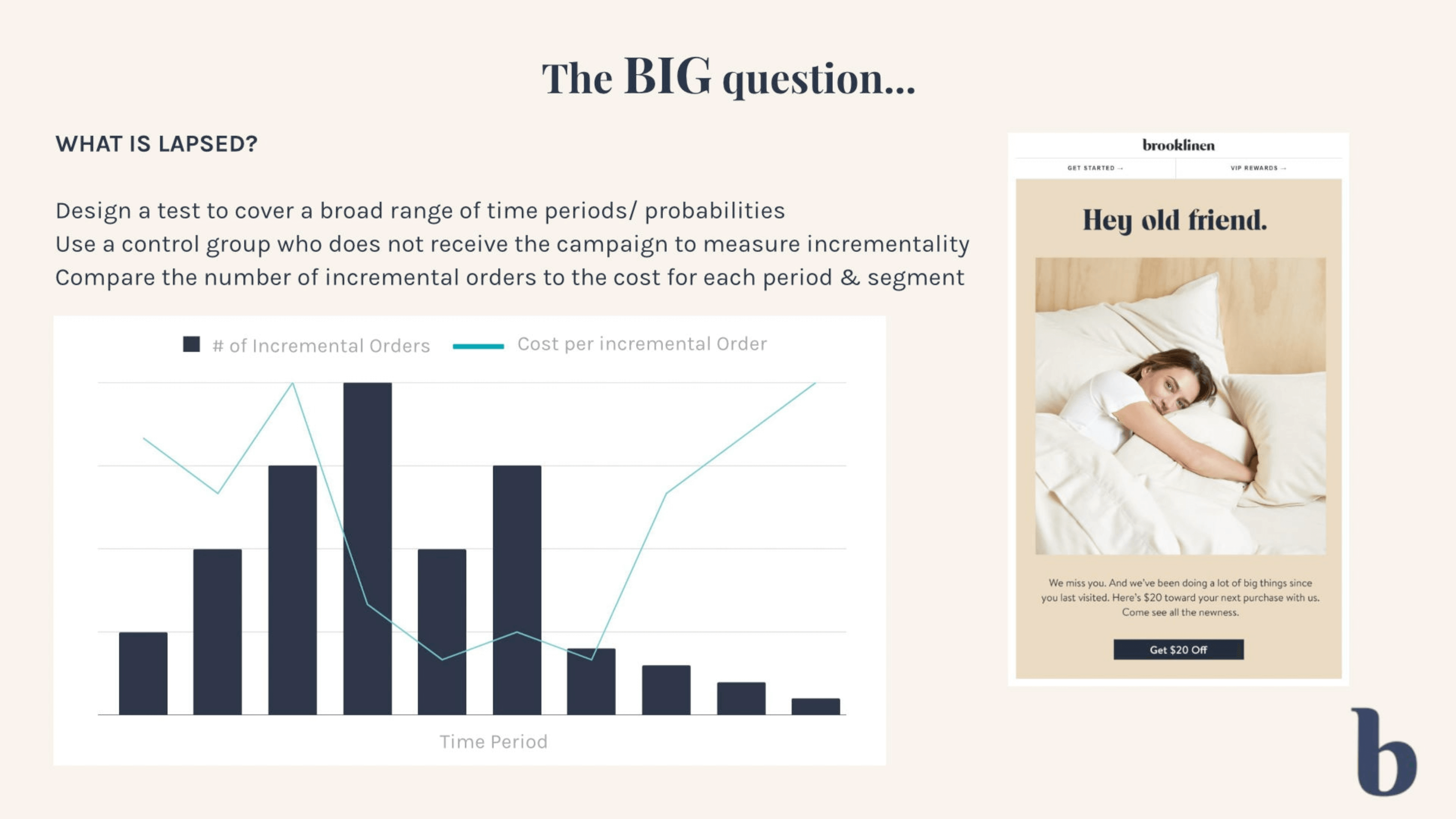
So the big question is - what is lapsed? I don't know about your office, but my office has a big argument about what is lapsed. It's going to differ between every single organization and every different business. If you're lucky enough to have a data science team, they might tell you it should be based on the customer's probability of returning. If you're working with marketers, maybe it's the time frame since the last period. Honestly, the only way to find out what is right for your organization is to test it.
We set up a test where we sent an email like this with an offer to a broad range of customers that we thought might be in the lapsed group. We sent half of them the offer, and the other half, we didn't communicate at all. Then, we compared how many orders came in with the test group versus the control group. We created a little chart like this with the bars that shows that at different time periods, people are more willing to come back than during other time periods.
Then, of course, we had to figure out how expensive it was for each group to come back. When you're thinking about costs, yes, it's channel cost. I know everyone claims email is free, but it's not. However, it could also be things like direct mail. Especially when dealing with lapsed customers, often, they're not opening their emails anymore. It's important to think through other channels that you might need to contact them through.
If you're giving an offer, if only 50% of my orders come in as incremental, I've still got to pay for the other 50 that came in that weren't incremental, which bumps up the cost as well. Finding a sweet spot for you, where you feel that the number of cumulative orders you're getting is high enough, and the price is something that you're willing to pay. How much you're ready to pay will depend on the amount of margin that you get back from those customers when they do return.
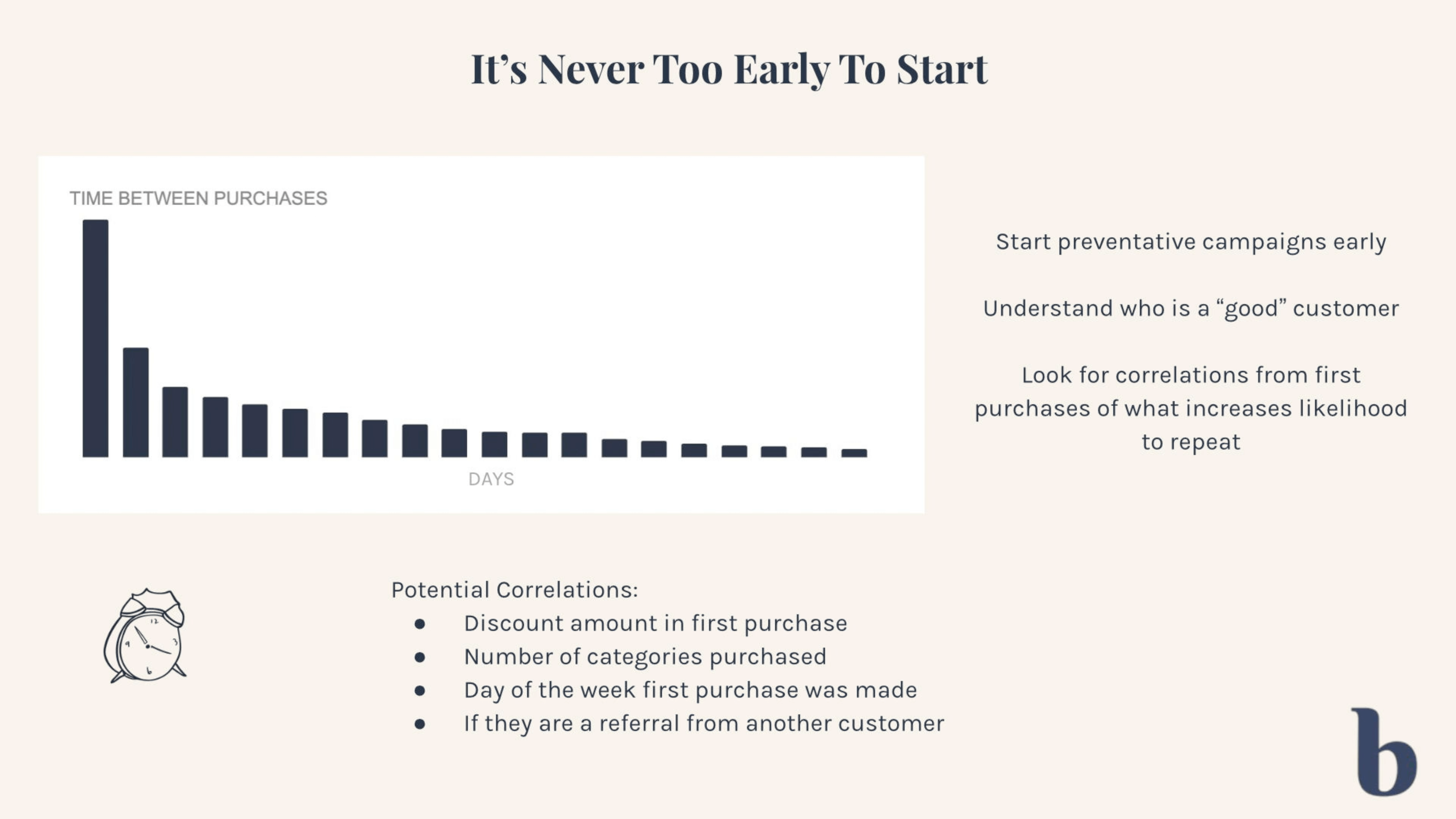
Even though that might be the best time to think about, "what is a lapsed customer for you?" it's never too early to start.
This is a chart of how long it takes our customers to come back and even bizarrely in the sheets industry when you think you don't need to buy your sheets very often. People are most likely to come back really soon after they just purchased. You need to capitalize on that love, where they feel that they want to engage with us and want to make a purchase. We start our retention campaigns pretty much the moment you make your first purchase.
I'd also tell everyone to understand who's a good customer. For all of us, it's going to be different. Whether you need to set an average order value so that your shipping is profitable, whether it's the amount of time people come in, if it's a subscription, how long they stay subscribed for. By understanding what is a good customer for you, you'll know whom to target. Let's be honest; if it's not a good customer for you and you're losing money on them, you might not want to bring them back.
Another big tip is to look for correlations for the first purchase, to see what makes them more likely to return. In a variety of different businesses, I found this to be random things.
My favorite was the day of the week they purchased on. We eventually dug deeper into this, and we found out that if they purchased on a Thursday, by the time it shipped on Friday, then nothing was moving through UPS, FedEx on Saturday or Sunday. So, the time it took for the item to get to them was so much longer than if you ordered it on a Thursday, your chances of coming back were pretty slim.
The correlations don't necessarily have to make sense to you at first glance. Other correlations I found were a discount amount on your first purchase, the number of categories you purchase in, and whether you were referred. In some companies, I've seen that if you were referred by someone, that could make you a great customer, and in other organizations, it can make you a terrible customer. It's very much down to an individual basis.
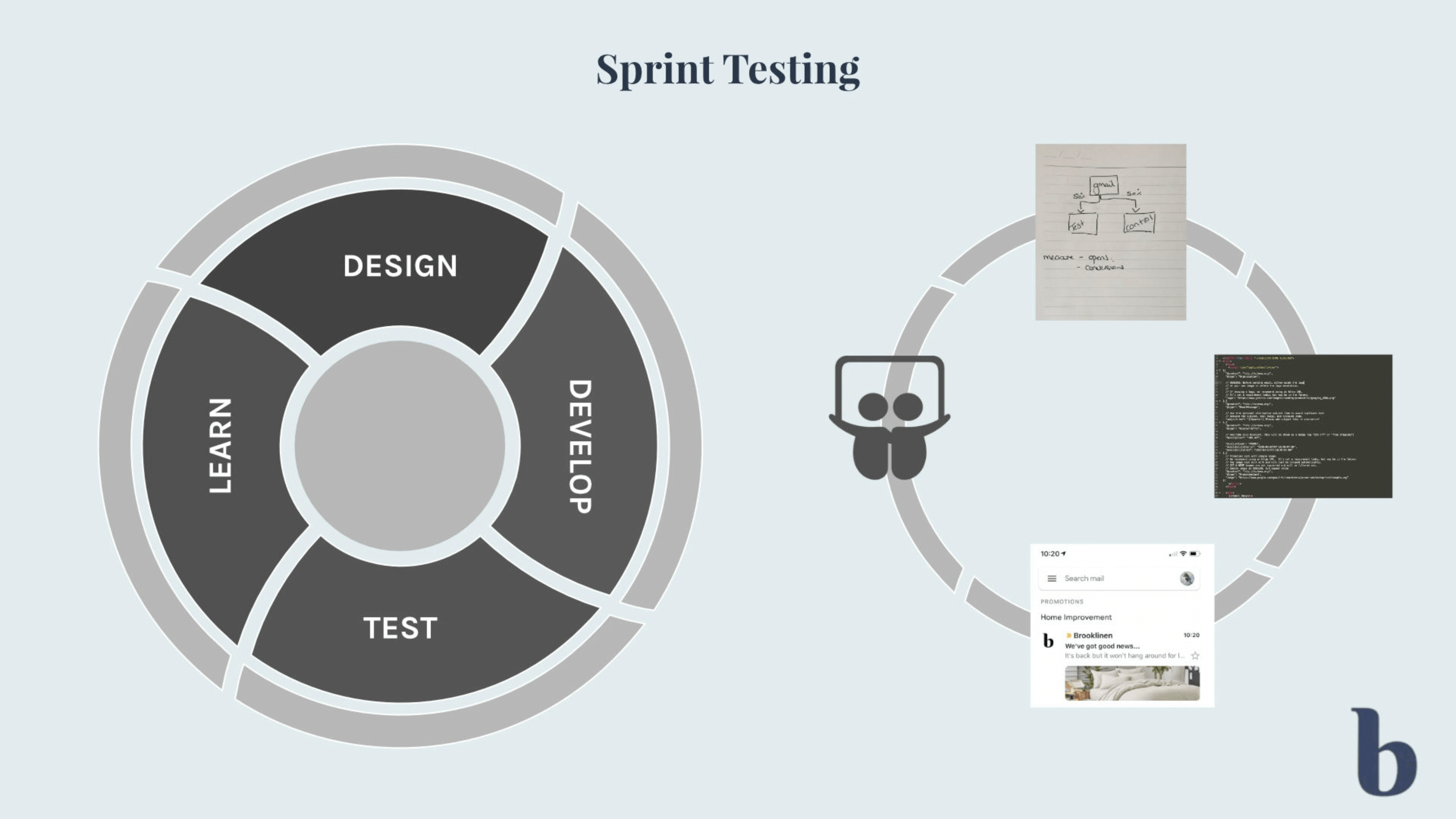
Yesterday we talked about stealing email ideas. I'm a big proponent of stealing things. Please don't tell the cops. I like to steal processes, and people should feel that tuning your process is not a bad thing. "Process" is not a dirty word. Even in a small team, process is a good thing to make sure that you're giving information and telling everybody everything they need to know.
I like to steal this from our product team. Our product team works on two-week sprints. I love this because we tend to set up workflows, and maybe it's for an abandoned cart, and you set it up, and you forget it. Perhaps if you're lucky, you tested it when you set it up, but then, you're not continually optimizing. There's always room to improve, and we know that our lifecycle flows are probably the most valuable things that we send as emailers.
It's important that you make sure that you continuously test and continuously evolve. It's going to make a huge difference. Unless you strike gold the first time, it is probably not the best flow that it could be.
Every two weeks, I sit down with my team, and we start designing tests, and we talk about all the tests we want to do. Each team member is given a separate segment to work on. So they all have objectives to make sure that their segment performs as well as it should. If it's making your first purchase, there's one person who sits there thinking about that flow to get them to make their first purchase all the time. Then, another person is thinking about why people stopped opening up the emails. They're continually trying to get that engagement rate up.
We sit down as a group, and we design the tests. These aren't necessarily pretty. You can see that they're hand-drawn things. We don't necessarily have beautiful documentation, but we make it work. We'll then go into a development phase, and often we'll try to do a quick dirty test. It doesn't matter if it's not the best thing we ever wanted to create. It may not be the most beautiful email because in two weeks, honestly, we're not going to get anything through our design team. We'll do something quick and scrappy to get a test and proof of concept. We will set it live and test.
I'm a big proponent of the promotions annotations in Gmail. If anyone's not using it, you should, unless you're in the linen industry, in which case, don't. If you don't mind just getting up and leaving, that'd be great. Everything I've told you here is a lie.
**Audience laughs**
Every two weeks, we then get back together and talk about what was successful and what we learned. It could be related to that one test, or it could be simple, like you know what, when it says their name in the subject line, they seem to open more. Stuff that can be shared between the different segments.
I know a lot of retention tests can not be done in two weeks. If you're trying to see your 90-day retention rates, it's tough to change in two weeks. This gives us that reminder to go back every two weeks, check how it's doing, and see if we should be changing it. Is it working? It gives us that little nudge, so that's why we do it.
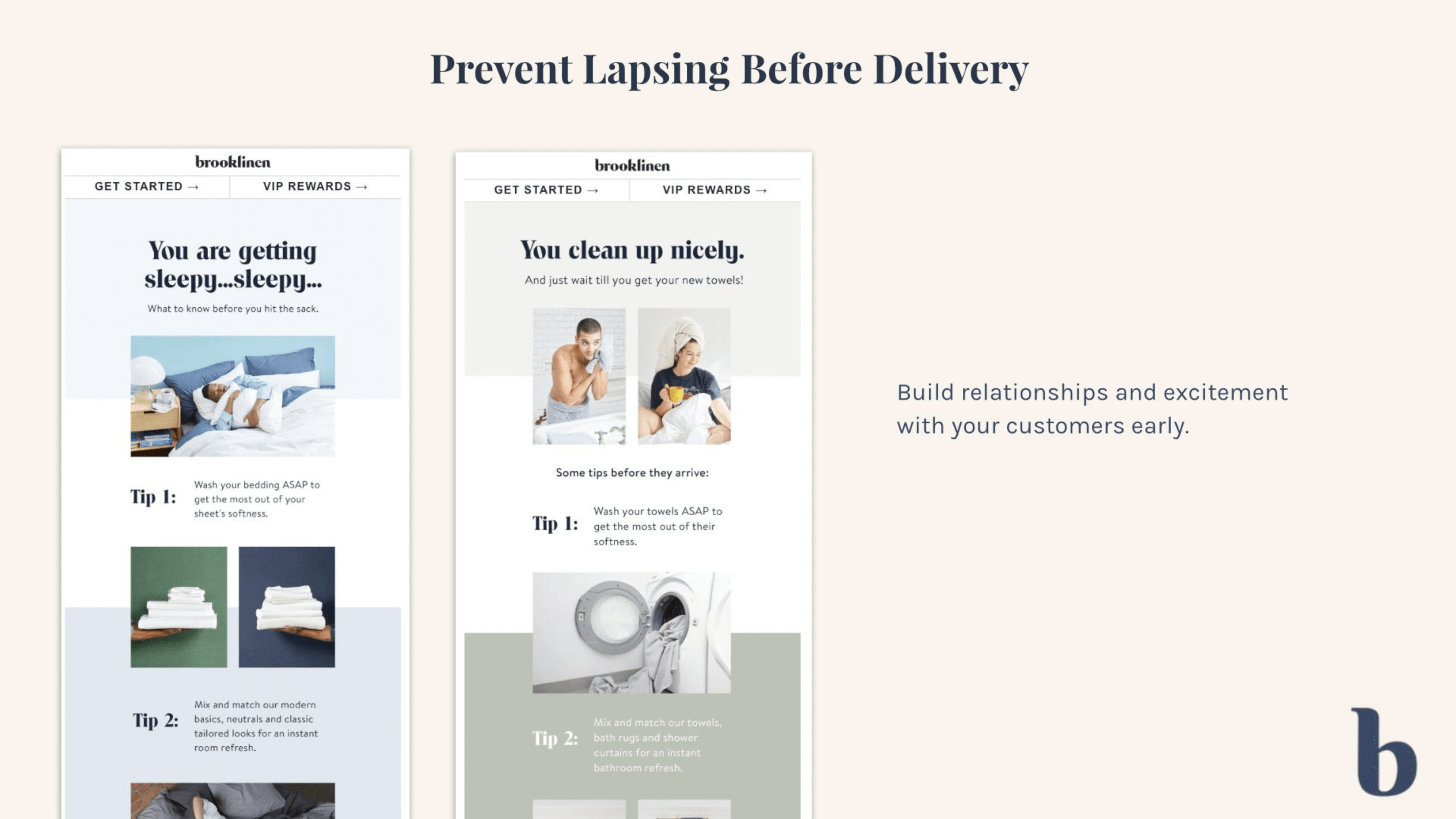
I will give you some tips that we're using. All the email examples are, unfortunately, Brooklinen. Sorry, but I'll be honest, they were the easiest examples to get a hold of.
So, how do we prevent lapsing? One of my biggest recommendations is that you can start changing the way people feel about your brand even before delivery. People are excited when they make a purchase, and you can see that they'll go back to the transactional emails for order confirmation delivery multiple times. They want to find out where their orders are, and they're excited. They feel that love for you already. You need to think, how can we contact them and give them useful information before they get their item that's going to make their experience better?
These are examples of tips that we send out before you get your package that should tell you useful things like, "you need to wash your sheets if you want the softest experience." It also helps us set expectations that if you put sheets that aren't washed on the bed, they're probably not going to feel as soft and lovely as once they've been through the wash and dry cycle. That also really helps keep our customers happier when they try the product for the first time. It makes everyone feel loving toward our product, rather than having a bad experience and then not realizing that they're not fantastic for one or two weeks until they wash them.
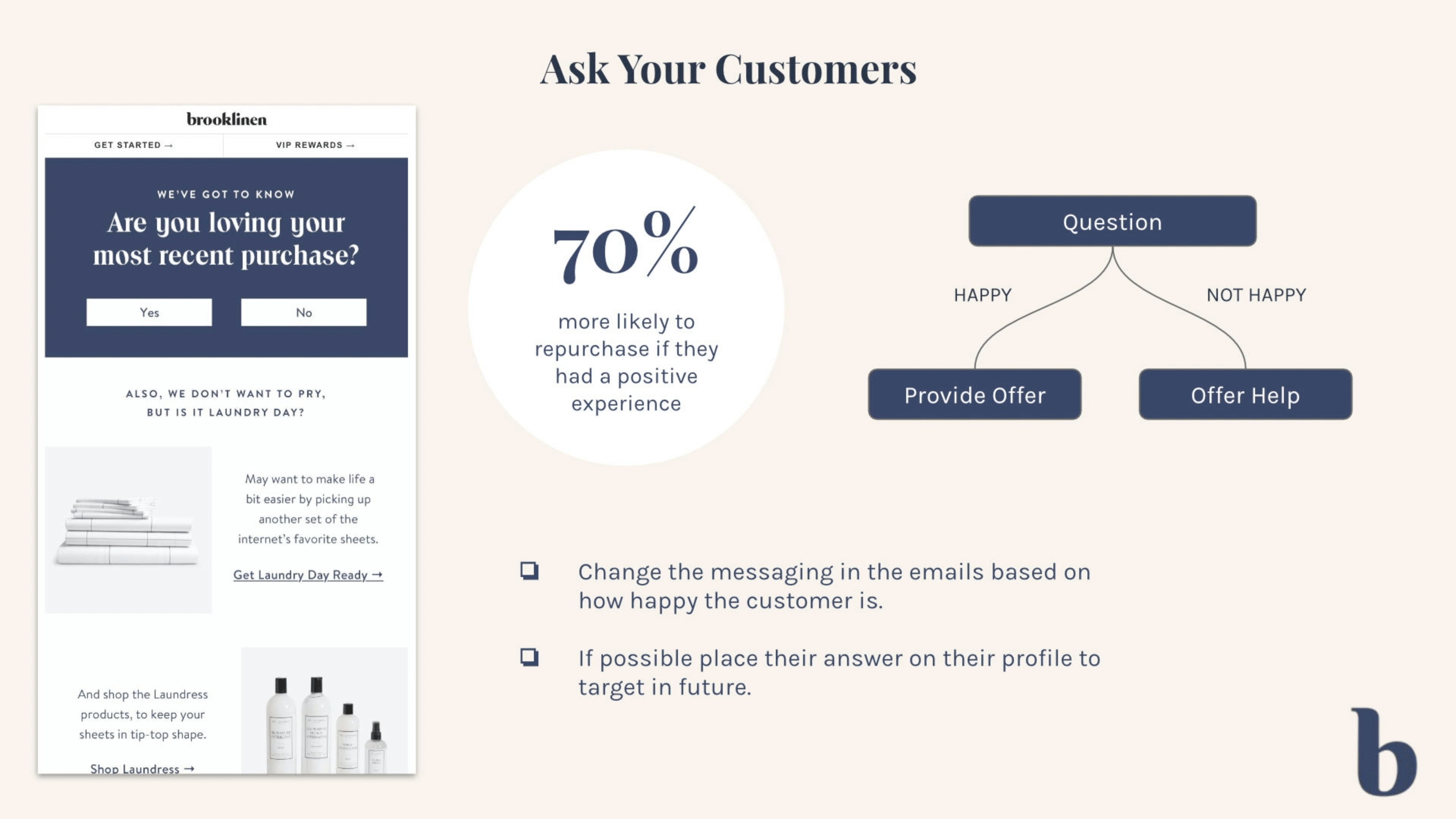
Then, we ask our customers how they're feeling. I'm going to share the most useless fact with you that you'll probably learn today; you are 70% more likely to repurchase if you're happy. I know you're thinking, no shit Sherlock. I flew out here to be told that your customers will buy more if they're happy. The reason we do this is not so much for that number, but really to understand who is happy and who is not. Self-declared data is probably the most powerful thing you can use to personalize your emails to people.
If our customers tell us they're happy, then we're going to give them an offer. That works to get you to come back because we know that you're likely to come back pretty quickly if you're happy. If not, we will try to offer you help and either send you to the website or get our customer service team in touch with you to make it better. What we also do that is quite interesting is that we put this on their profile. Then, in our ESP, we can now see if they were happy or not happy during the first purchase. We can always go back and target, and then try to look and change behavior later.
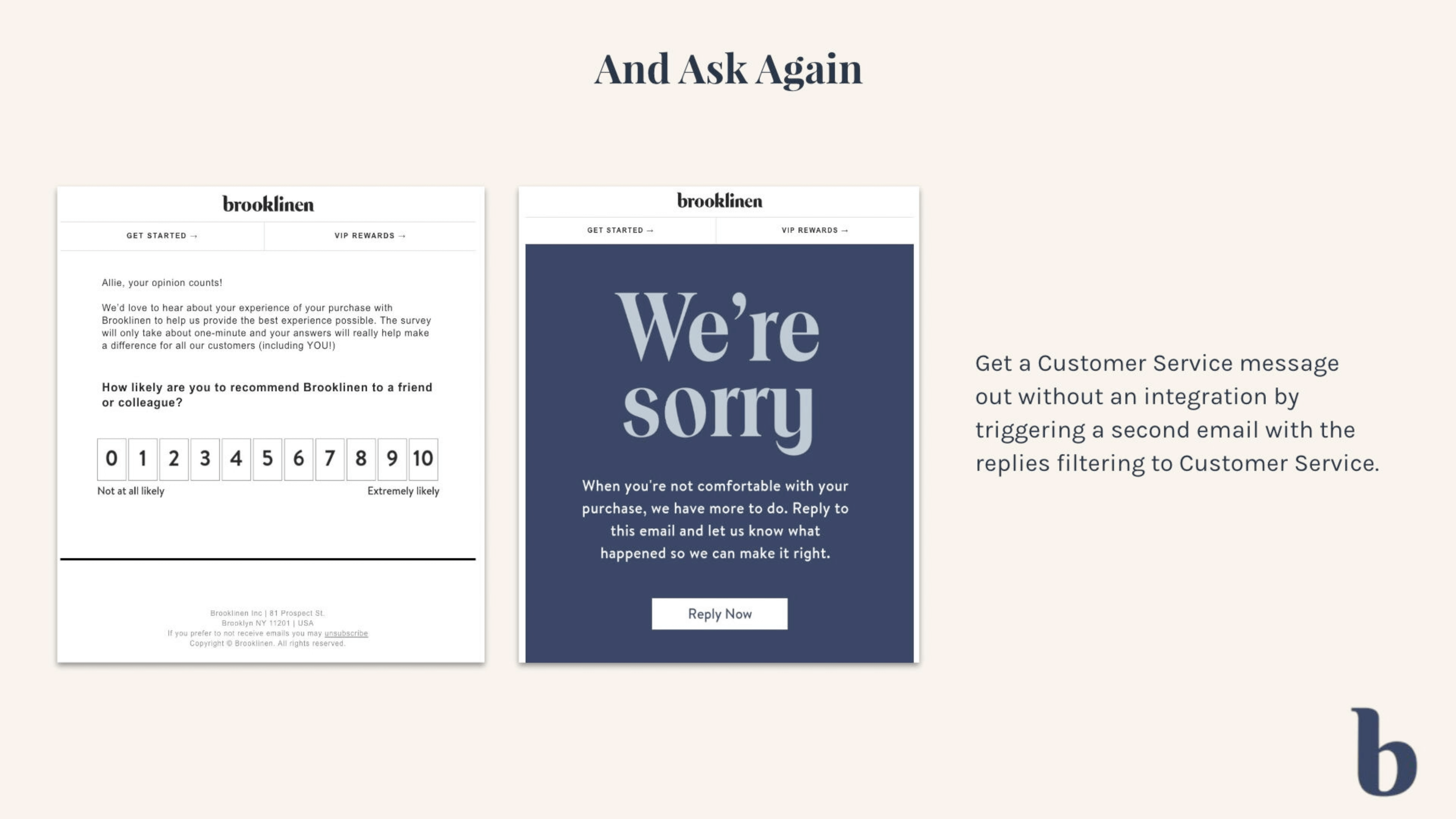
After we've asked, we ask again. We tend to use a really simple question for the first purchase. After the first purchase, we rely on NPS for a couple of reasons. I know everybody has mixed feelings about NPS, but it works well to score how happy our customers are in general. You'll see it fluctuate after we have an event and different types of customers come in. We also put this score on their profile, and we track their NPS scores, so we can see when their behavior changes. As a newer customer, we often see that they're much likely to rate us lower, and as an older customer, though, they will rate us higher.
I know this email example is hideous. This was a two-week test. He's getting a re-design, so hopefully, if you do make a purchase anytime soon, you'll see a prettier or more handsome email.
We discovered a quick little cheat, with me being the engineer on the team, and I know nothing about engineering. I wanted a way that if you said you were unhappy, customer service could get in touch. What we didn't do was connect it to our customer service platform. However, what we did do was trigger another workflow that would send an email that said, "we're sorry, get in touch and reply to it," so that it would filter directly to our customer service because all of our emails go to our customer service team when you reply to them. That was a little hack to get around having to do any engineering work and still get everything to customer service.
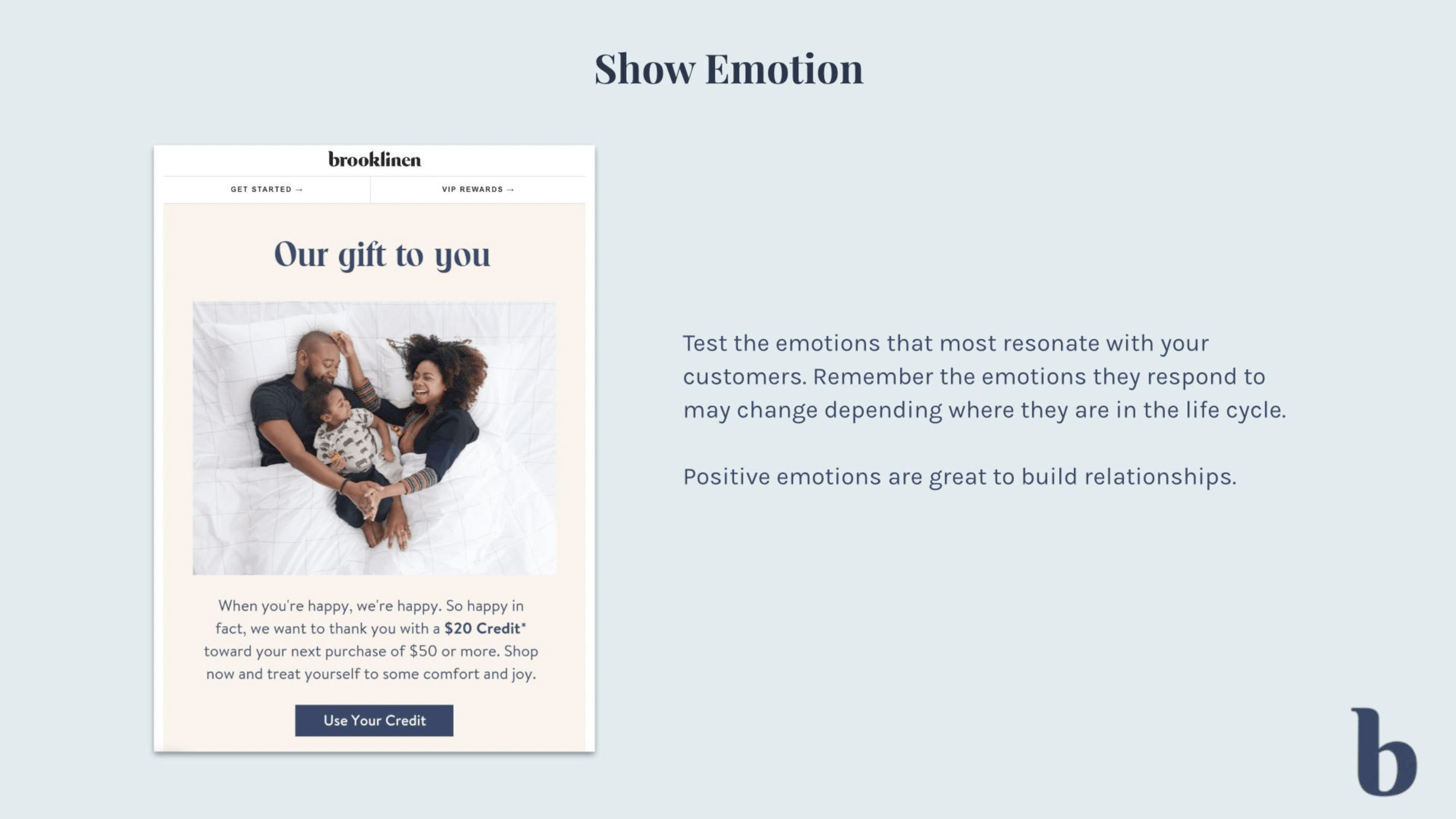
I'm a big proponent of showing emotion, talking about your feelings, not to your partner, but just to your customers. It makes it easier.
*Audience laughs*
Especially in the retail world, we tend to focus on the negative emotions- fear, urgency, and the feeling you're going to miss out. When you're building long-term relationships, you want to think of those positive emotions, the achievements, the appreciations of the world. You've unlocked, you've done it, we're thankful for you. Those kinds of emotions help you build those relationships with your customers.
Then, we have a cute example of our post-purchase flow, where they make a heart shape because we love you, and we'll give people $20 credit to come back and try us a second time.
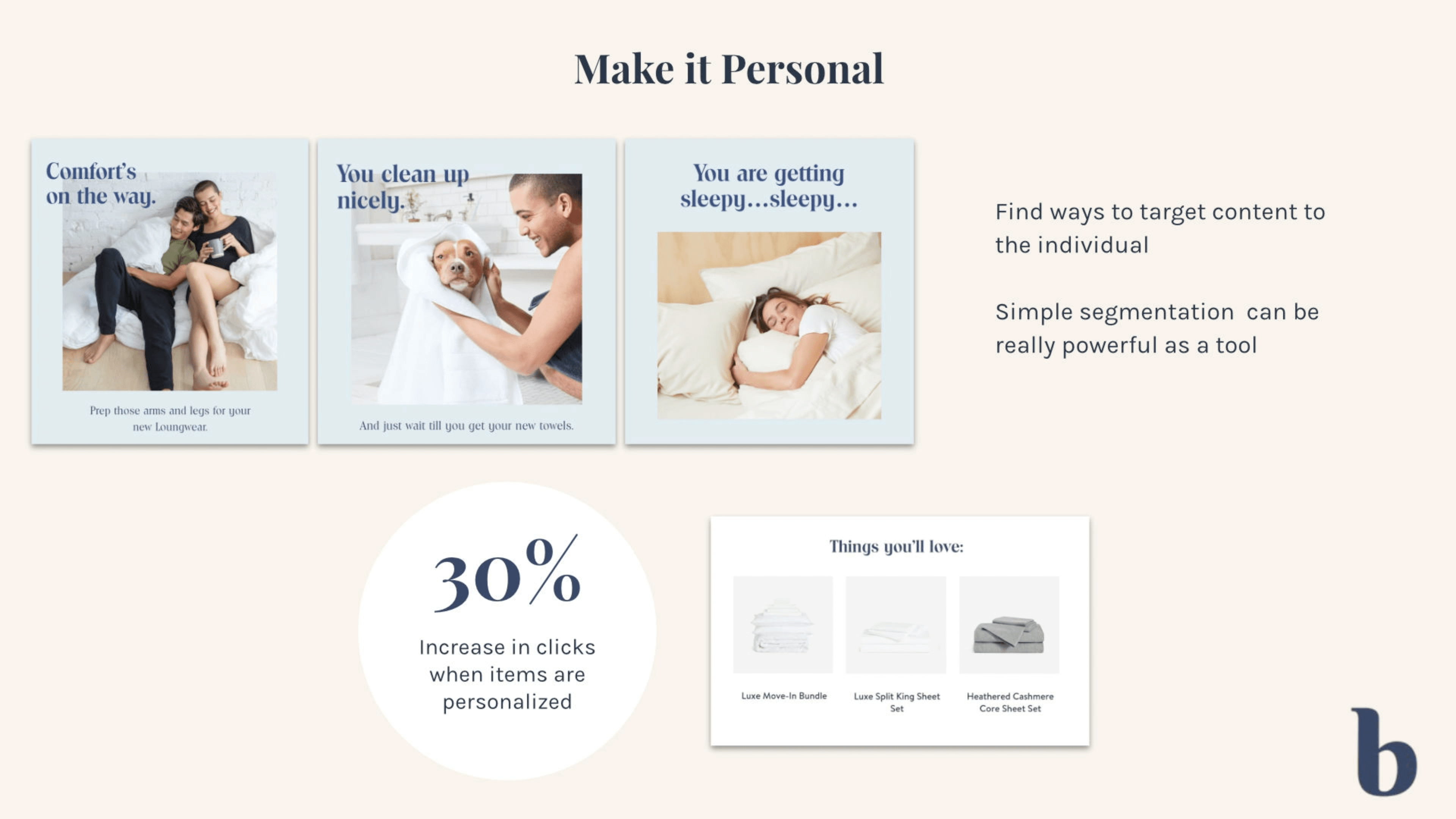
I know we just talked about personalization, so I'm not going to repeat it, but we want to make things personal. We were one of that 70% who did not know how to use our data and couldn't do any personalization a few months ago. We had to get a little scrappy and a little hacky.
The problem we had with our ESP was, we knew what you had purchased in an order through an event, and you could use that event to trigger in a workflow. However, if you wanted to use that information anywhere else in any other workflow, any additional email campaign, you are out of luck. If I wanted to send you an email about towels because I knew you bought towels, there wasn't much I could do about it, apart from creating a list and blast people.
What we did was when you make a purchase, as an event, we now put another attribute on your profile so that we know what you purchased, and we can use that again. Then they all add up. So we can see how many different categories you're buying in, and we use them to personalize.
This top example is from one of our emails that essentially will either show you loungewear, towels, or sheets, depending on what you've expressed interest in. We found this powerful. Even simple segmentation, here we only have three versions, but they can do a lot before you start thinking about getting into really deep personalization.
We've recently gotten into personalized product recommendations. I'm going to be honest; we cheated. We got someone who could do this for us. We pulled these in using Movable Ink because we felt that the algorithms they could do and the information they could provide with us were much more robust than anything that we could develop in-house that wouldn't take a good couple of years.
The way this works is it looks at the items you've browsed, then it looks at the things that everyone else has browsed, and what they went on to purchase, and it will show those recommendations to you. We're still working on not having white items on a light gray background. It turns out that was a big technical problem. Otherwise, we've seen a 30% increase in clicks.
What's interesting is we can get to the type of sheets you're interested in. If you ever want to be bored by sheets, just let me know. There's a lot of different weaves. I know more about sheets than I thought I would ever know, honestly. Various sizes, different materials, and we sell a lot more than just sheets these days as well. All those things get pulled into the recommendation engine, and the computer is 30% smarter than I am, which is great.
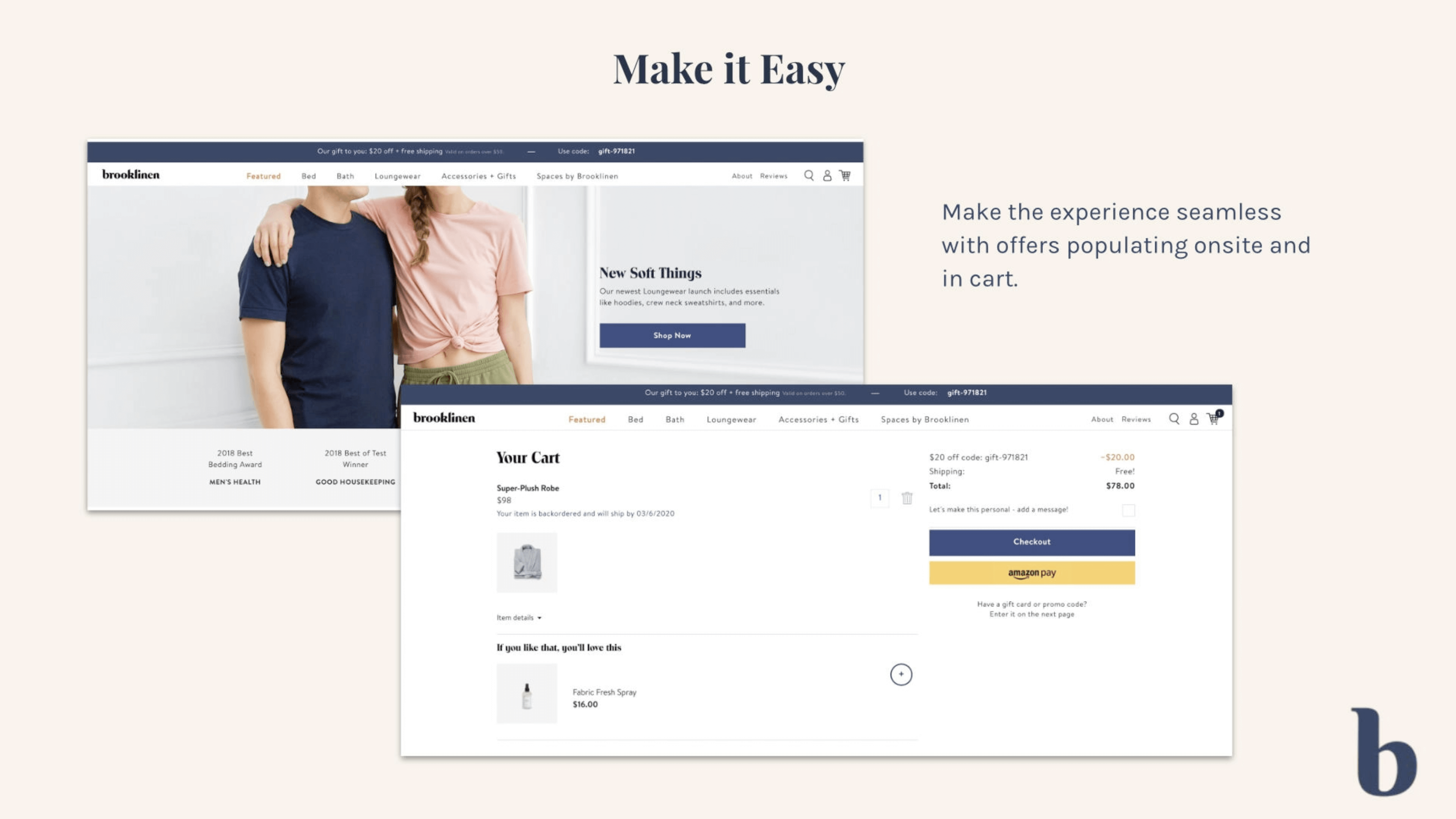
I also want to talk about making it easy. We've tried to replicate the email experience with our web experience. This is an example where you click through from an email, and it gives you the same $20 offer. It's both at the navbar on the top of the website and in your cart. This worked well for a while. If we were sending you an email that said $20 off, click through, this worked.
What wasn't working was that if we sent you any other email that didn't specifically say $20 off, there was nothing in the email that would tell the website to trigger the same offer. One day I might be telling you $20 off, but the next day, maybe I'm just saying you should buy sheets, and now you're $20 appears to have disappeared.
We put a fix in place, again a little hacky, but just by having UTM's will help our website understand what that customer should be seeing. Again, it's all related to the attributes we put on their profile. Pretty much, the easiest thing we figured out how to do in our ESP is put something on their profile, and then you can target it anywhere else. A big recommendation is to put as much information as you can on someone's profile.
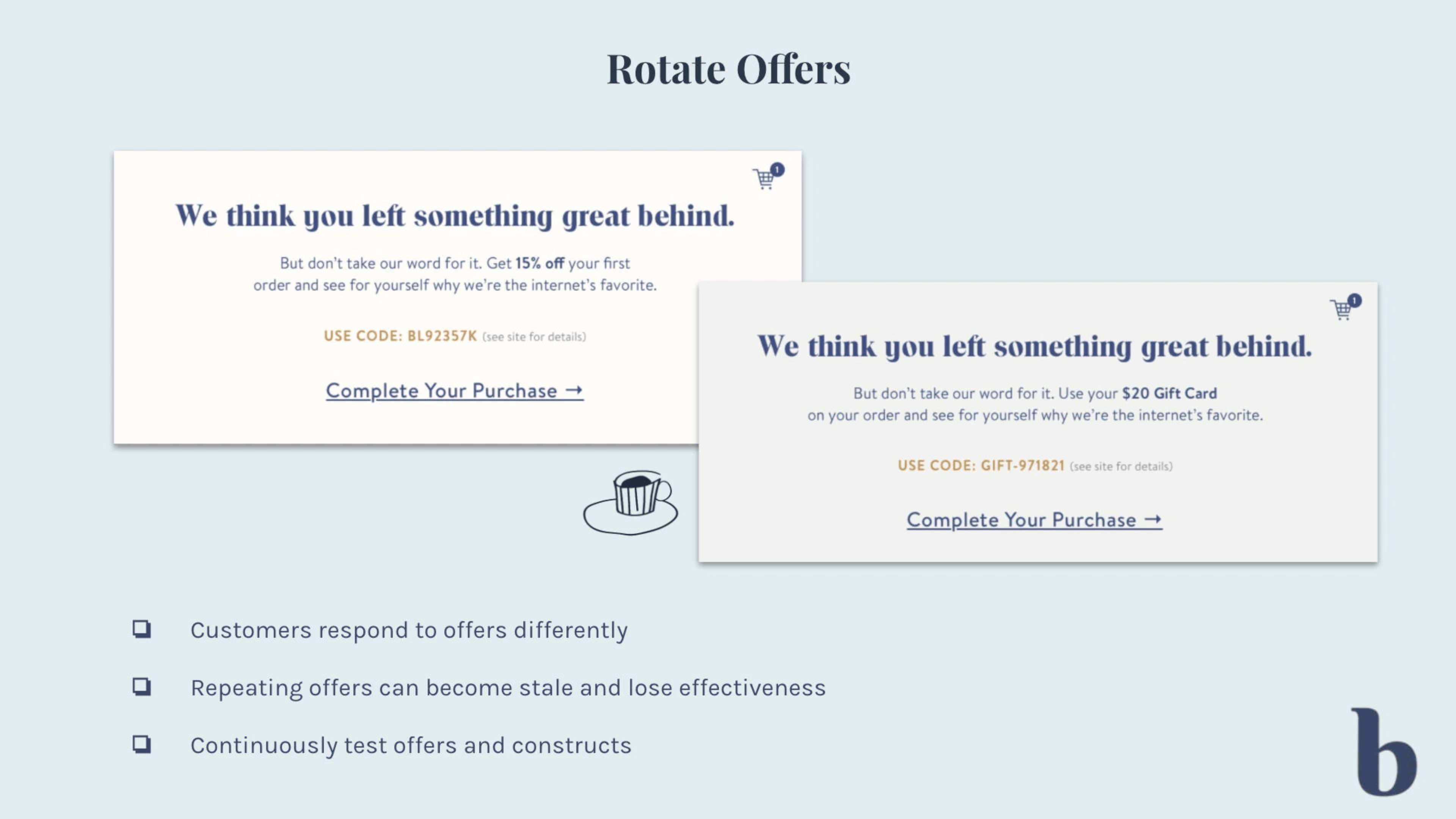
Now, offers. I'm sure most people have probably tested offers in some form or other. Maybe you know that dollars off does better than percentage off, or perhaps it should all be about a free gift. However, what is difficult to get down to is, what does each individual need? Even if you test your offers by segment, different people will respond to offers differently.
Some people like to do the math and figure out that 15% off may be better than $15 if I spent $100. Other people might just be like, I don't care about $15, but free stuff gets me.
One of the tactics we do is that we rotate our offers. So, to the same segment, one week, they might get a 15% offer, and then a couple of weeks later, maybe they get a $20 off offer if they didn't purchase and take the action we wanted them to take. This also helps those offers from becoming stale. If we send the same offer every single email, there's only so many times someone can see 15% off before they just decide it's not for them, and they unsubscribe.
Continue testing. You never know what's going to work, you're lucky if you strike gold the first time you test an offer, but sometimes it's the bizarre constructs, whether it is tiered promotions, which might help increase your AOV if that's important for you, or, it could be that your customer is looking for something straightforward, easy to understand. Then, maybe a straight discount off works better for you. Keep testing and keep rotating and just making sure that your customers are not getting bored with your offers.
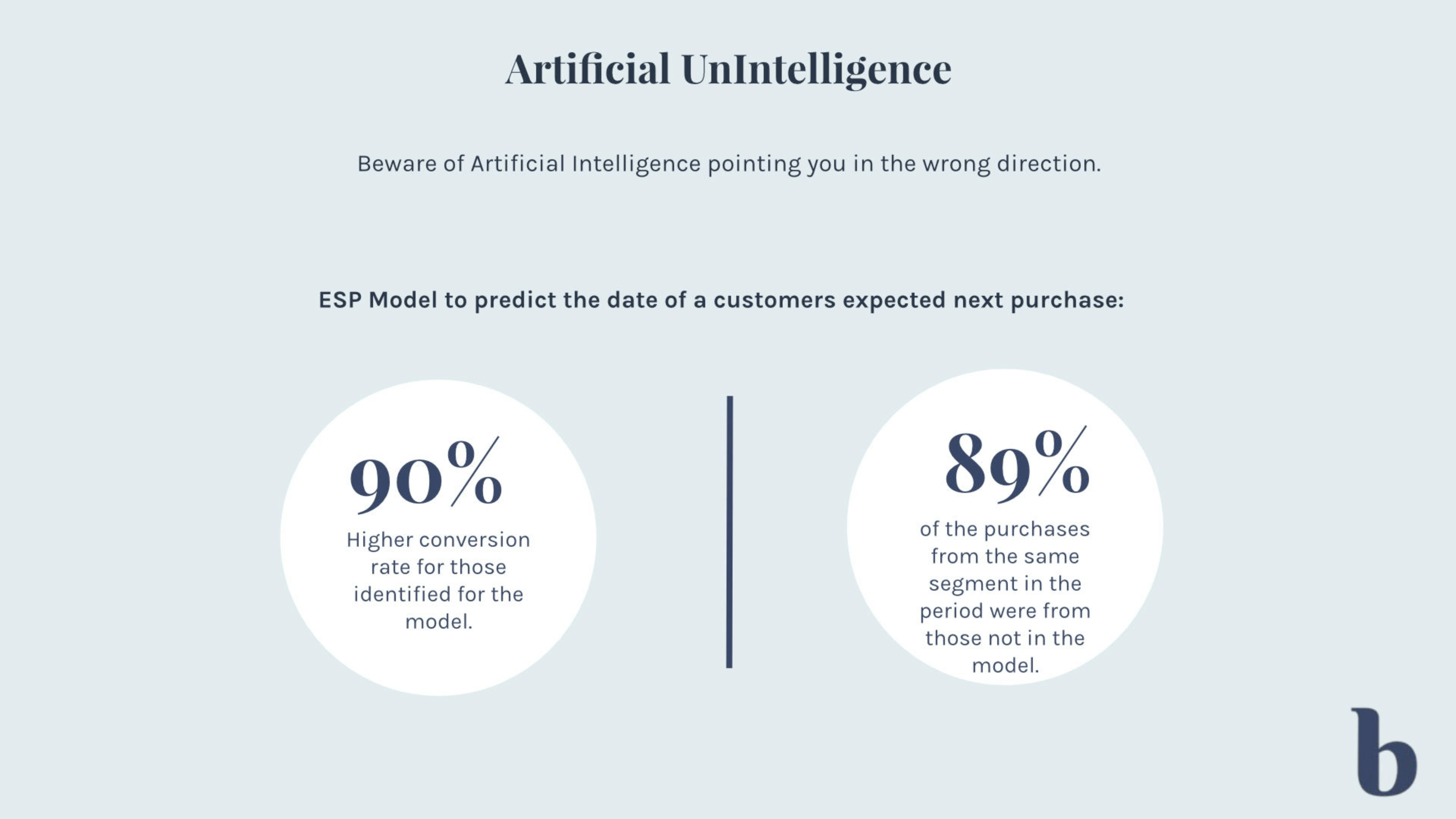
I just told you how great artificial intelligence could be. Now I'm going to tell you how dumb it can be—artificial unintelligence. So, my ESP came to me and said, You know what, we have a model that can predict when your customer will make the next purchase. And then anything later than that would be lapsed. This sounds great. My job is over. You've replaced me. We're good.
However, we decided to run a test on this. We took everyone that the model said would purchase in the next month from just one segment of people, they were all multiple purchasers, so we had a lot of good data on them. Then we watched. The ones that model said, a 90% higher conversion rate, which we are re like great. This is perfect. This is everything we ever wanted. Something that can predict who will make a purchase.
We then looked at the rest of the segment and who made a purchase during the exact same timeframe from the same segment. We saw that 89% of all the purchases during that time from that segment did not come from the people in the model. So, there's an element that yes, they certainly can predict some of the people that are going to make the next purchase in the right time timeframe, but they're missing the far majority.
This is a real risk when we think about segmentation. If we start segmenting this 10% off that we're going to miss 90%. We're going to miss the larger part of the segment. That's where a lot of the money will be coming from. I'm always very skeptical about artificial intelligence. Test it, make sure it works for you. Then make sure that there isn't anything dirty hiding there, which makes you lose at least 90% of your revenue.
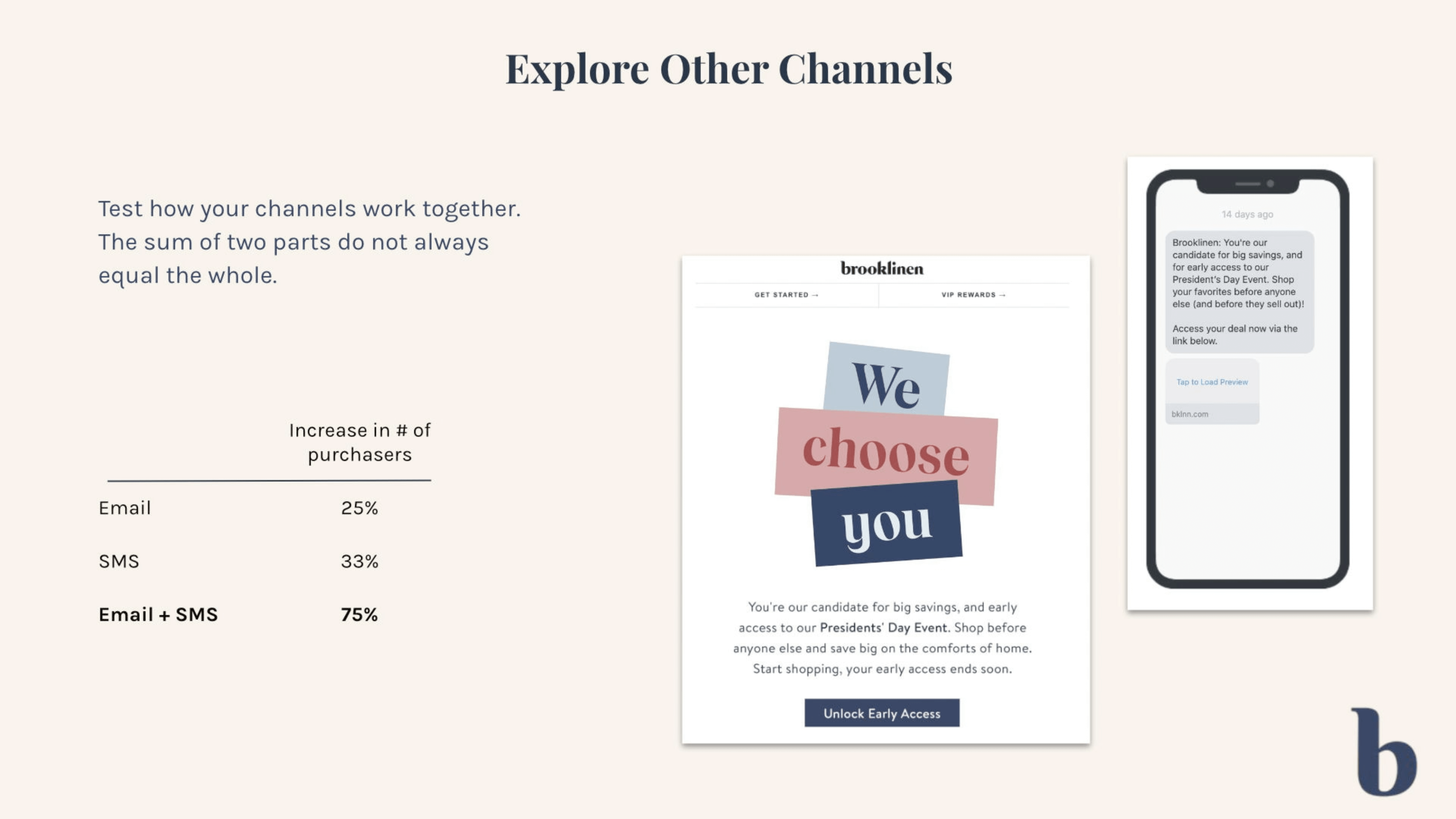
I know we're at an email conference. But you know, many people yesterday said that
we have other channels, other things that we're all doing. So I would encourage everyone to work with your partners in other channels or with yourself if it is you. Think about how your channels can work together.
So we run a big campaign for President's Day. We sent it to people via email, SMS, an SMS and email, or nothing. We found that if we sent an email, we got a 25% lift over sending nothing at all. So at least, my job is doing something. SMS, we got a 33% lift. Let's be honest SMS gets a better lift because our most engaged customers are on SMS. That's whom we asked for SMS details originally. So it's a bit of a hack. I do love SMS, but it's not quite as rosy as the picture looks.
Then email and SMS. The email had a 75% lift. And even with my bad math, like the sum of the whole is not the sum of the parts. So it's really interesting that sometimes people need multiple communications on multiple channels. So I would implore everyone to find what those channels are. Maybe it's SMS. Perhaps it's direct mail. Perhaps it's smoke signals. It could be anything.
I'd also like to make an impassioned plea; if there is an ESP in this room when you're building emails and looking at GIFs. This drives you crazy. Does anyone else look at their GIFs for hours on end, going around and around and around? I'm tempted just to leave it up here so that you can look at it for the next like two hours, and we'll go stir crazy. So yes, any ESPs in the room, can you please make a way to stop having to look at the GIFs 70 times? If one thing comes out of this, I would like it to be that.
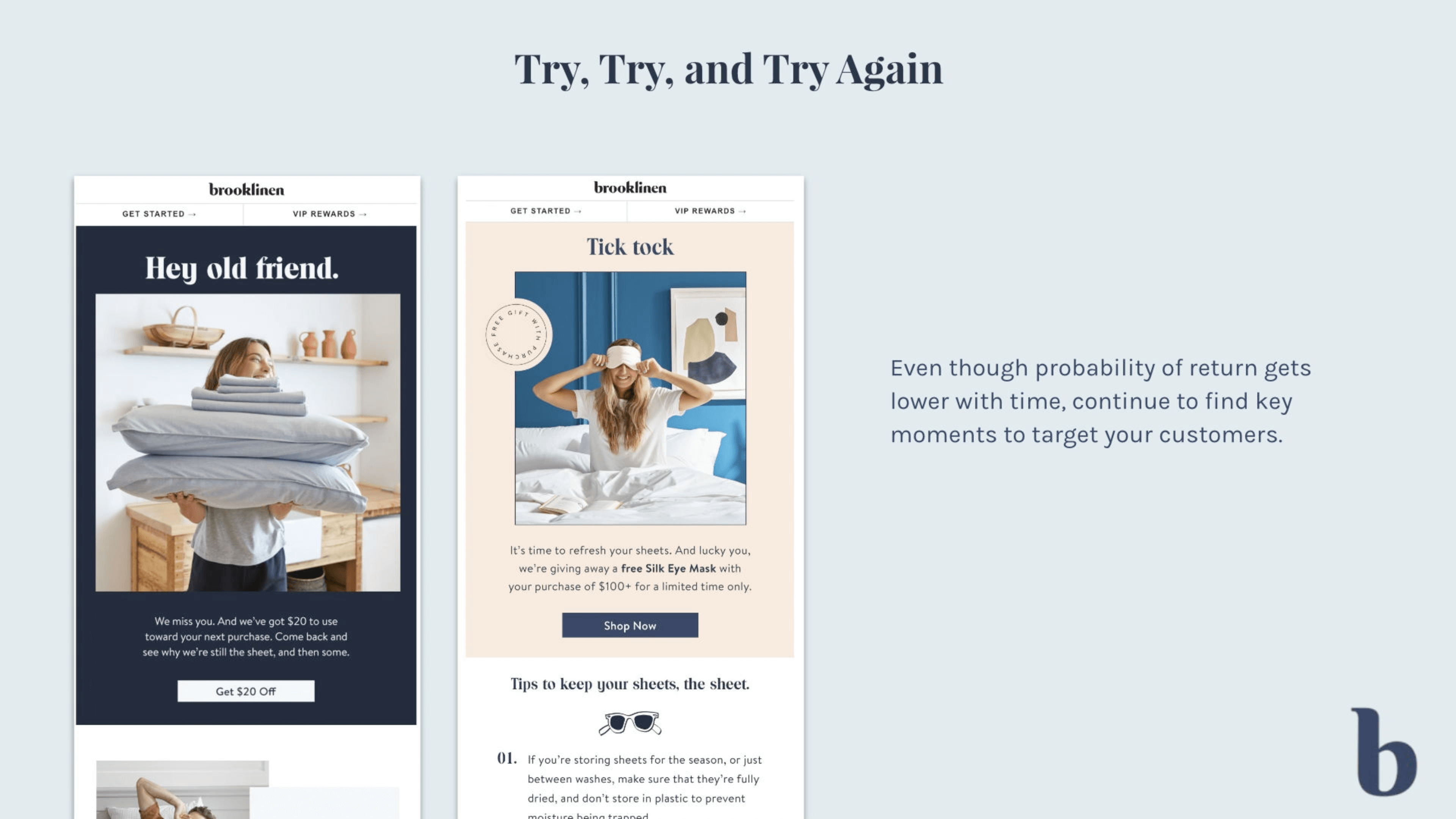
The last thing I'm going to recommend to you is to try, try, try again. Your customers will lapse, and they're going to become less engaged, and they're going to leave you more. But you can still get them back. These are two examples from one year and two years elapsed.
Sure, the results are nowhere near as good as if I send an email to people who recently purchased, but people do come back. People don't necessarily mean to leave you. They might think that they don't need any sheets. They just ignored your email for two years, and now I've decided to look at it again.
It's tough to know what's going on in people's lives. Keep contacting them. Don't give up on your customers. They may come back eventually.
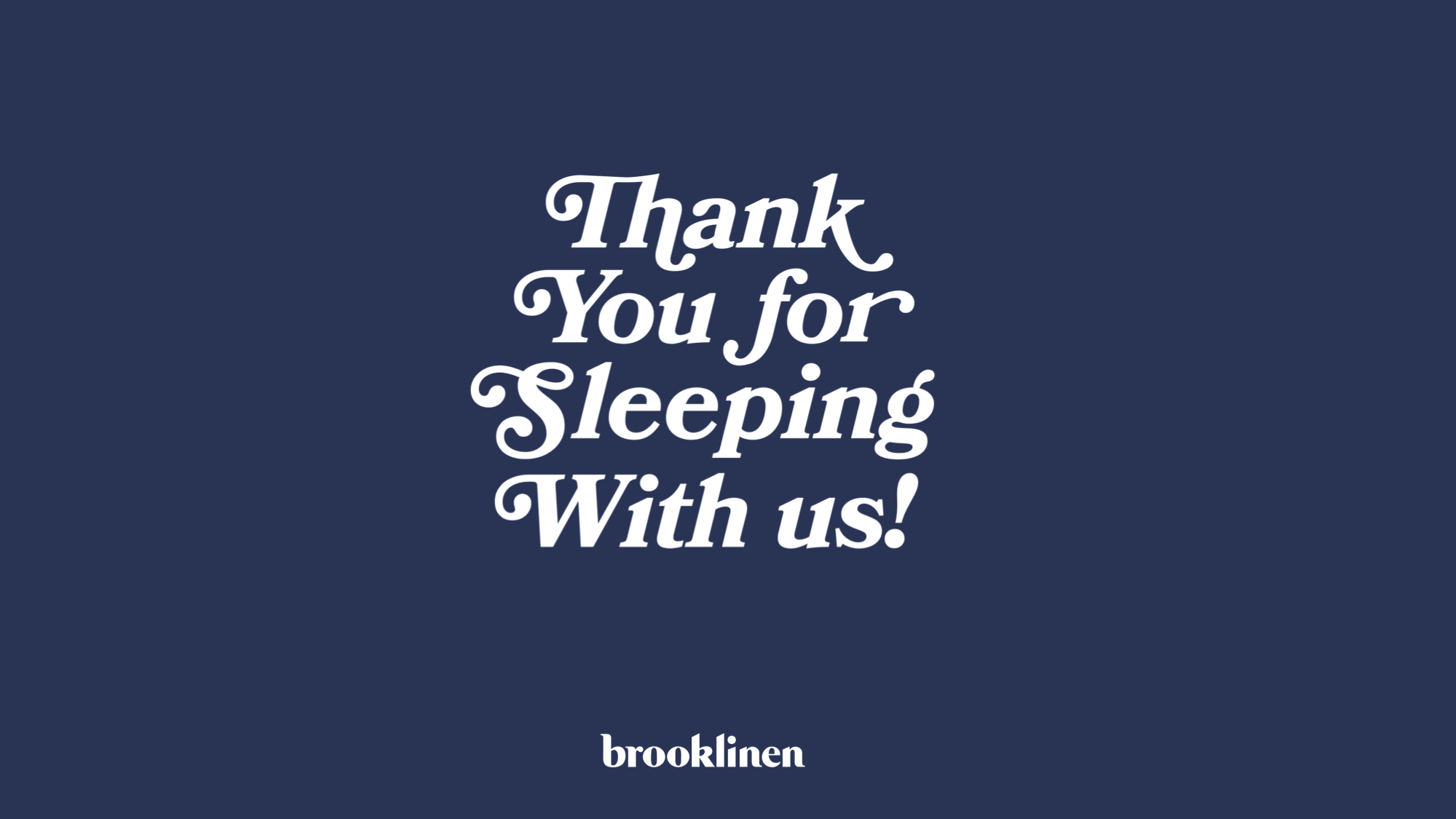
That's it from me. Thank you.
Any questions?
Audience Member: Do you split test or track retention by gender?
Allie Donovan: So we've struggled to get good gender information. We use some tools that can tell us from credit card details and are general. Sometimes we do ask people. We found that we sway more female than we do male, not that surprising, but we haven't explicitly tested gender. We do try to have a mix of models when we're using humans in our photography. It's still not something that we mainly focused on yet, but it could be in the future.
Audience Member: So the "make it personal" email you referenced, do you use one email with conditional statements to render each version? Or do you send all three separate emails?
Allie Donovan: The answer is one email with multiple conditions. It's easy when you have two or three versions to manage three different emails, but by the time you get to more and more versions, it doesn't become sustainable. It also means that your process gets longer. Now somebody has to QA three whole emails. So I'd always instead build one email with more versions, just to cut down on the production time as well.
Audience Member: You showcased the one-year and the two-year retention emails, but how much during those times of retention are you still emailing them actively, or have you sunsetted them?
Allie Donovan: Pretty much constantly. It depends on how they interact with us. So if they stay interacting with our emails, they'll keep getting them. If they interact less or stop, they'll start getting them less frequently and only get the big messages from us, the sales or Black Friday type messaging. We try to keep everyone on the database for as long as possible, but we also try to re-engage them in other channels. So if you still open our emails, we might send you a direct mail to just kind of be like, "Hey, remember us?" We never stop emailing until they completely stop opening our emails.
Audience Member: I have a question about your post-purchase survey if you are happy or not. If they say they are happy, you give them an offer. I was curious about the process behind that decision because you might have spent so much money to acquire this person, and you finally got them to purchase, and then you're spending more to get their next purchase. What was the testing process behind the different offers? Why are you choosing to send an offer to someone who just purchased?
Allie Donovan: Yeah. We don't want to pay for all this we don't have to. We did do the math and figured out whether it makes sense to or not. The return we get by getting so many customers back does make it worth it. It's going to depend on how much it cost you to acquire in the first place, what your margins are, all those kind of things. But for us, it does make sense. They don't necessarily all use it, but it gives us a great way to say thank you to them to make them feel appreciated. Even if they don't use it then and come back a few months later, it warms them up for us.
Audience Member: For those unengaged subscribers, do you put them on a separate IP for sending purposes until they re-engage?
Allie Donovan: We do not. Right now, we keep them all together. We do monitor our deliverability. We make sure that if they stop engaging with us, they eventually stop receiving emails.
